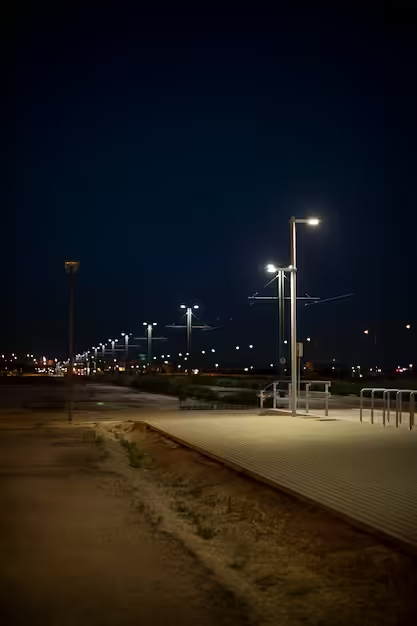
Get A Quote
7 Tips on How to Design Street Lighting
7 Tips on How to Design Street Lighting
Are you looking for LED street lighting to be the best seller in the market? If your answer is yes, keep reading. What makes the street lighting outstanding? The key is the design of LED street lighting. If you find the right design, customers will swarm to buy it, and you will make good money in this industry.
How to have a popular street light design? And what are the street lighting design standards? Today, we'll share 7 important tips for designing street lights that work, from picking the right bulbs to understanding different plans and design details.
Tip 1: Choose the Right Lamps
Selecting the appropriate lamps is a crucial aspect of street lighting design. You have several options like high-pressure sodium lamps, metal halide lamps, low-pressure sodium lamps, incandescent lamps, CFLs (used mainly in lanes or streets), and LED lights. And LED lights are increasingly favored for their energy efficiency, longevity, and superior performance.
Tip 2: Consider Luminance Level and Uniformity
Luminance plays a significant role in how well drivers and pedestrians perceive their surroundings. Proper luminance levels ensure that the contrast between objects and their backgrounds is adequate. And according to CIE standards, areas five meters away from the road on both sides should be illuminated to at least 50% of the road's illuminance level to enhance visibility.
Also, chieving luminous uniformity is equally important. Luminous uniformity, which measures the ratio between minimum and average luminance, ensures visual comfort for road users.
Tip 3: Address Glare
Glare, visual discomfort due to high luminance, must be minimized in your street lighting design. There are two types of glare: disability glare and discomfort glare. Disability glare is less of a concern, while discomfort glare can result from poorly planned lighting schemes. To ensure a comfortable experience for road users, always consider glare limitation in your design.
Tip 4: Implement Proper Lamp Spectra
Matching the lamp's spectral characteristics with the environment's needs is essential. Proper lamp spectra help in maintaining visual sharpness, and can make it easier to recognize objects' size and dimension, thus improving safety.
Tip 5: Ensure Effective Visual Guidance
Street lighting should guide users in estimating the distance between objects accurately. Effective visual guidance is crucial for creating a secure environment. It helps drivers and pedestrians gauge distances and make informed decisions on the road.
Tip 6: Understand Road Types
Different types of roads require distinct lighting designs. CIE classifies roads into five types: A, B, C, D, and E, based on factors like traffic volume and speed. Each road type necessitates specific lighting solutions to ensure the safety of road users.
Tip 7: Consider Pole Arrangement Schemes
The arrangement of streetlight poles depends on the road's width and the purpose of the lighting. The four common arrangements are single-sided, double-sided, staggered-sided, and central verge position. The choice of pole arrangement should be made based on the road's characteristics and requirements.
When designing your street lighting, ensure that the spread and throw angles of the luminaires align with your chosen pole arrangement to maximize illumination effectiveness.
Street Lighting Design: Key Parameters
Understanding the key parameters of street lighting design is vital. These parameters include the average maintained luminance level, overall uniformity of illuminance, longitudinal and transverse uniformity, disability and discomfort glare, and unit power density. These parameters help you calculate the number and spacing of luminaires required for your project.
How to Compute Average Illuminance
Average illuminance is a crucial metric in street lighting design. It is calculated using the Lumen method, accounting for factors like the maintenance factor and coefficient of utilization. By determining these factors, you can accurately compute the average illuminance on the road surface, ensuring the desired levels of lighting.
Point Specific Luminance and Illuminance
Point specific luminance on the road surface is related to the point-specific illuminance. It is influenced by the angle of incidence and the plane of light incidence. Calculating point-specific illuminance from an Iso-Lux diagram of the street light helps ensure consistent lighting across the road. If you want to know more, check Why Do Some Stadium Lights Point Up?
Glare in Street Lighting
Addressing glare is crucial for creating a safe and comfortable environment. Understanding the two types of glare, disability glare and discomfort glare, allows for effective glare control in your street lighting design.
Lighting Design Guidance: Dimensions and Spacing
Proper spacing and height of light fixtures are key factors in creating uniform illumination. Factors like street typology and land use determine the ideal pole height. Spacing between light poles should be based on the height, and the light cone's diameter should match the fixture's height to prevent dark areas.
Conclusion
By following these seven tips and understanding the key parameters of street lighting design, you can create safe, efficient, and aesthetically pleasing lighting solutions. And when you're ready to implement your design, consider Infralumin's high-quality LED street lights to bring your vision to life. With their decade-long experience in the lighting industry, Infralumin is a trusted partner in your journey to design well-lit, secure streets.

